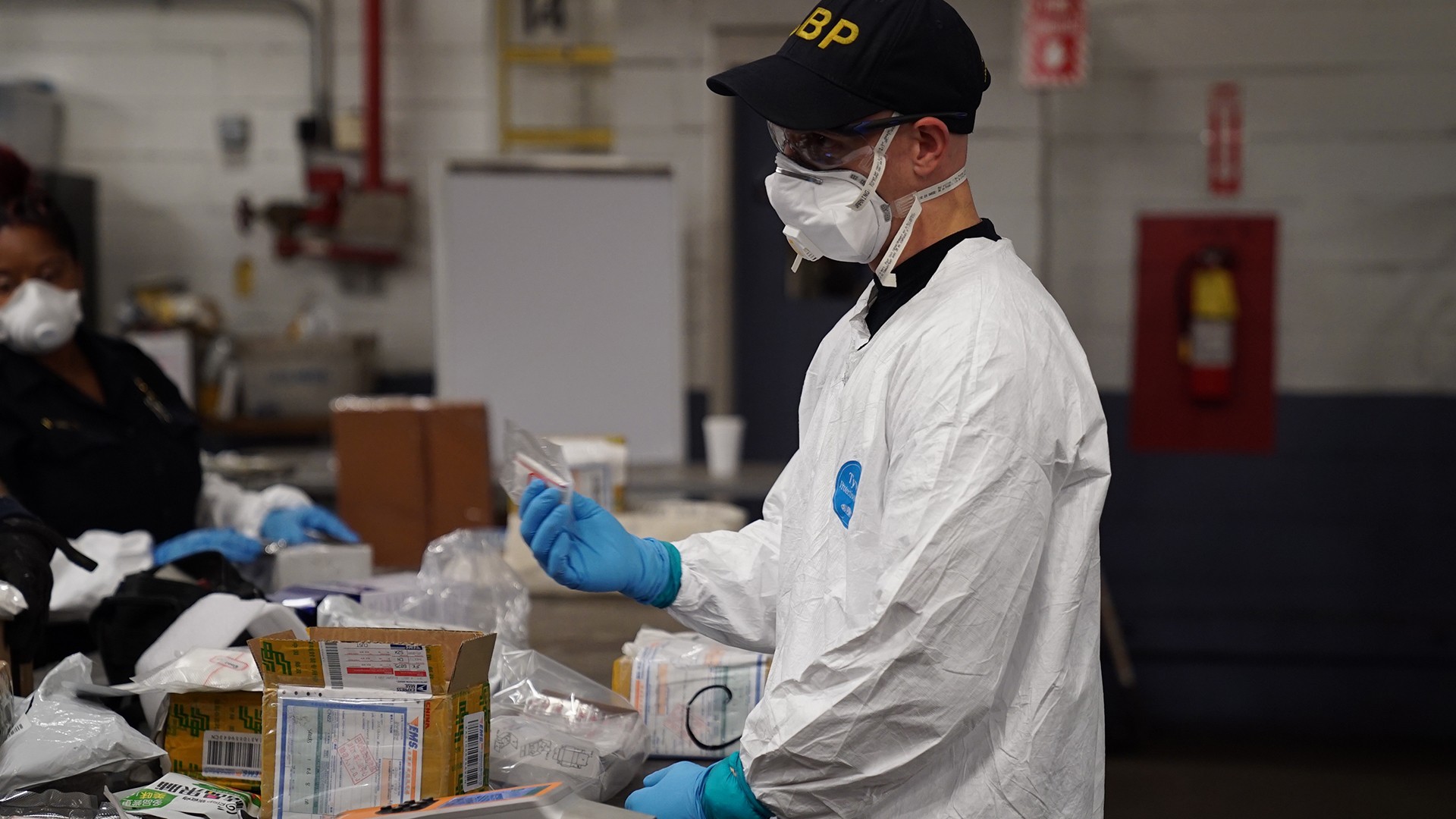Left Image: Photo by David Hannah/Getty Images Right Image: iStock/Getty Images Plus
28-year-old Andrea* works as an embalmer at a high-end funeral home, where every two weeks or so, she prepares the body of a young, white, rich person who died of overdose for burial or cremation. She knows she could just as easily be the one on the cold metal table herself: she has OD’d at least four times, she said, with paramedics telling her she was “clinically dead” during the last one.Until recently, however, Andrea was not aware of a likely cause of those near-death experiences. Each time she needed to be revived, she ultimately realized, came on a day that she’d injected opioids shortly after taking her morning dose of (legal) anti-anxiety medication. Her story illustrates why America’s so-called “opioid overdose epidemic” may be more accurately defined as a kind of “multiple drug poisoning” crisis, one that needs to be much better understood in order to save lives.

Although the numbers vary by location and by year, a large proportion of opioid overdose deaths in recent years have involved not just one drug but many. One CDC report found that nearly half of such ODs nationwide involved consumption of drug cocktails, and in New York City, the local health department has repeatedly reported that upwards of 90 percent of overdoses involved the interaction of multiple drugs. In Ohio, meanwhile, a study in 2015 found that the cause of death for 73 percent of overdose victims was linked to more than one drug—and nearly a quarter had four or more drugs listed.All of which means that grasping how drug mixing occurs, why some people do it deliberately, and how to reduce or mitigate it, is critical. In Andrea’s case, part of the problem was lack of awareness: she didn’t realize that her prescribed medication could interact so dangerously with illegal drugs, she said. In fact, taking opioids along with other drugs in the “depressant” class is uniquely dangerous.Depressants include alcohol, benzodiazepines like Xanax and Klonopin, Z drugs for sleep and other drugs that have a sedating effect. “We talk about benzodiazepines a lot, but we don’t talk about alcohol,” said Jon Zibbell, a senior public health scientist at RTI International, a nonprofit research group. “It’s important.” (Oddly, a lot of research that tracks opioid overdoses fail to include alcohol in the data.)Taken with opioids, depressants can have a synergistic effect that slows breathing—their individual propensity to suppress respiration is multiplied when they are taken together, not just added. Of the roughly 8500 overdoses linked to benzodiazepines in 2015, roughly 90 percent also included an opioid.But mixing opioids with stimulant drugs like cocaine or methamphetamine—commonly called speedballing—can also kill you. While their opposing effects on wakefulness and heart rate can sometimes cancel each other out and may even reduce risk in some instances, in other cases, this can simply overload the system.Unfortunately, little research has been done on the motivations of people who mix drugs. From interviews with people like Andrea and those who study what is known as “polydrug use,” however, several important issues become clear.The first, as Andrea discovered to her cost, is lack of awareness. While she had heard mixing depressants was risky, she didn’t realize just how intensely these substances, taken in combination, could magnify the respiratory depression each produced on its own. “I was aware that I was combining, but most of the time I didn’t even think about it,” she said, adding that she was not suicidal.“I felt like I was cautious to a point, but there were a good handful of times, right before pressing down the plunger, I was thinking, ‘You know, this might kill me,’ and kind of being a little concerned—but not caring that much.”Andrea, who grew up in a household that she describes as being “in the top 1 percent,” said she never felt comfortable with her status. “I felt like I could never fit into this perfect life I was supposed to live, so if I couldn’t go to that extreme, I might as well go to the other and just fuck everything up.”Her mental health problems started early. She became so depressed during elementary school that she refused to leave home, she said, and by ten she was taking Zoloft. After that, she began cycling through different medications and periods of institutionalization, including being held in a program that she said used harmful and abusive tactics. During adolescence, she recalled, she began misusing a friend’s ADHD drugs. By her 20s, she’d discovered opioids, cocaine and crystal meth.Even with the lack of data on polydrug use, we do know that for opioid users, drug mixing is the rule rather than the exception. And while childhood trauma and pre-existing mental illness are ubiquitous among people with addiction in general, they are even moreso here.For example, studies suggest 75 percent of people with heroin addiction have another mental illness, with a full 50 percent showing psychiatric problems before age 16 and up to half meeting criteria for post-traumatic stress disorder (PTSD). At least half were abused or neglected as children, with especially high rates of sexual abuse as well as other traumatic exposures: researchers have described the typical experience as a “shattered childhood.”Elizabeth Brico, who has written for TONIC and now has five years in recovery, comes from the opposite end of the economic spectrum as Andrea. Her single mother was a refugee from Cuba. By 15, Brico said, she was using methamphetamine with an abusive partner, a man who got her pregnant and regularly choked her so badly that it caused seizures.“After that, I had PTSD,” she said, describing how she discovered opioids seemed to relieve her symptoms. “It did something it hadn’t ever done for me before. It made me feel better and able to do things,” she added of her post-PTSD opioid use. But, in order to “potentiate the high,” Brico said, she often added Xanax or Klonopin. The combination “made everything just black out or go away, which is what I wanted.”That is the most dangerous type of polydrug use—where the goal is to extinguish consciousness, at least temporarily. Although Brico said she had times when she did want to die, mostly, her aim was escape. “Making myself go away for a while seemed like a great idea,” is how she put it.36-year-old James Brewer from Campton, Kentucky, has also mixed opioids, methamphetamine and benzodiazepines. He said bluntly that he, too, sought “oblivion.” He added, “I wasn’t purposefully trying to kill myself. I just didn’t want to live life.”But he stopped combining Xanax and opioids after friends began dying from that very mixture in the bathrooms of rest areas and gas stations in his community. In the rural area where he lives, he continued, “About 13 people I know have died from OD.” He has now been in recovery for three years.Several additional motivations for mixing also seem to be in play here, with one centering on using other drugs to extend the opioid effect in hopes of avoiding withdrawal. Robert*, who is 40 and lives in New Jersey, took benzodiazepines and alcohol to try to cut down on opioids, he recalled. “I didn’t want to use such large amounts,” he told me, adding that his overdoses began when he could no longer illegally obtain prescription opioids, and counterfeits—which likely contained fentanyls—came on the scene. (He is now six months free of opioids.)While “speedballs” have always been common among heavy opioid users (I was a big fan in the past), the current trend of mixing opioids with stimulants is being shaped in part by the explosion of fentanyls. Noting that the latter have such a strong sedative effect that they are used as anesthetics, Zibbell said, “More and more people are saying they are using stimulants just to stay awake” rather than seeking the mixed rush of the combination.Disturbingly, this same impulse may be part of why meth and coke overdose (and use) have also risen so sharply in recent years. Overdose deaths including cocaine and opioids more than tripled between 2000 and 2015—but cocaine deaths without opioid involvement actually declined.Still, a great deal remains unknown about how fentanyls are re-shaping the illicit opioid market and what proportion of overdose mixtures that contain these drugs would have been deadly even if the fentanyl was taken by itself.In Rhode Island, for instance, less than a third of overdoses involve mixtures, according to Traci Green, associate professor of emergency medicine at Boston University. That’s down from nearly 40 percent, she said, due to the fact that “fentanyl on its own is more lethal.”Green has conducted research over the last few years surveying over 300 drug users in three different states about their drug preferences. “75 percent did not prefer or seek out fentanyl,” she told me. However, some said they took it because dealers were selling it cheaper than substances they labeled as heroin. Her interviews also picked up the trend of people adding coke or meth to fentanyl in order to stay awake, function, and raise money for the next high.In this complex and fast-moving crisis, a better understanding of why people engage in the riskiest behavior is crucial to save lives. While some people do deliberately take deadly mixes to blot out consciousness, many others appear to be doing so because they don’t realize the danger, because they want to save money, or to counteract over-sedation.To help, we need to recognize and address each of these motivations—and reach out to people who are often seeking relief, not death.“It wasn’t until I woke up with the paramedics saying, ‘You were dead,’ that I realized that I did care about living,” said Andrea, who recently started taking the anti-addiction medication naltrexone (Vivitrol).*Some last names have been omitted to protect the identities of people in recovery.Sign up for our newsletter to get the best of VICE delivered to your inbox daily.Follow Maia Szalavitz on Twitter.
Advertisement

Although the numbers vary by location and by year, a large proportion of opioid overdose deaths in recent years have involved not just one drug but many. One CDC report found that nearly half of such ODs nationwide involved consumption of drug cocktails, and in New York City, the local health department has repeatedly reported that upwards of 90 percent of overdoses involved the interaction of multiple drugs. In Ohio, meanwhile, a study in 2015 found that the cause of death for 73 percent of overdose victims was linked to more than one drug—and nearly a quarter had four or more drugs listed.All of which means that grasping how drug mixing occurs, why some people do it deliberately, and how to reduce or mitigate it, is critical. In Andrea’s case, part of the problem was lack of awareness: she didn’t realize that her prescribed medication could interact so dangerously with illegal drugs, she said. In fact, taking opioids along with other drugs in the “depressant” class is uniquely dangerous.Depressants include alcohol, benzodiazepines like Xanax and Klonopin, Z drugs for sleep and other drugs that have a sedating effect. “We talk about benzodiazepines a lot, but we don’t talk about alcohol,” said Jon Zibbell, a senior public health scientist at RTI International, a nonprofit research group. “It’s important.” (Oddly, a lot of research that tracks opioid overdoses fail to include alcohol in the data.)
Advertisement
Advertisement
Advertisement
Advertisement
Advertisement
